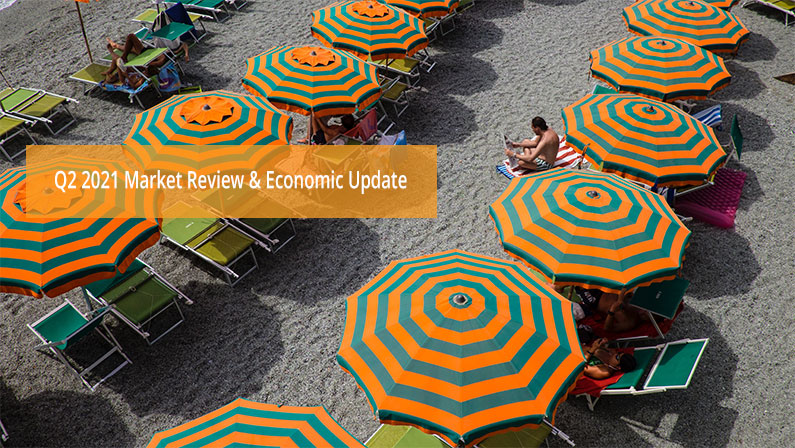Market & Economic Update – July 2021
July 14, 2021
By Peter Mueller, Steve Taddie & The HoyleCohen Investment Committee
Global markets finished the first half of the year on a strong note, with markets closing at all-time highs reflecting optimism for current economic activity, future growth, and expectations that global central banks will keep interest rates low and liquidity high – thus providing fuel to economic conditions and market returns. In the US, the Standard & Poors 500 stock index closed out its fifth straight quarterly gain, continuing its comeback from the pandemic low in early 2020 and advancing 14.4% in the first half of the year.
The factors supporting domestic market returns and growth expectations continue to be covid / vaccination programs, the Federal Reserve and its stimulative monetary policy (low interest rates and adding liquidity to markets via its bond purchase program), the corporate earnings recovery (S&P consensus estimates point to 60.8% year-over-year earnings growth), government spending or stimulative fiscal policy (via pandemic assistance such as CARES Act and pending infrastructure spending proposals), and finally the expectation that any increase in above normal inflation will be temporary. While these factors remain positive catalysts to economic and market conditions today, one must be vigilant for changes that can affect market direction and investment sentiment as we move forward. For example, while the vaccination story in the US is a positive one relative to many other countries and supportive of improving economic conditions, we remain short of our goal which has the potential to delay herd immunity. As viruses do, they adapt and change, which has resulted in the Delta covid variant becoming the dominant strain in the US. As the Delta variant case count increases, markets begin to focus on the uncertainty of economic and life normalization which can stymie profit growth and put pressure on stock prices. While these concerns should be temporary as the vaccines are expected to provide effective protection against this variant, it can cause some added volatility in financial markets and conditions and/or crimp economic growth.
On the economic front, the Federal Reserve met in mid-June to evaluate its economic and monetary policy and remains reluctant to take the punchbowl away from the party. Economic growth, as measured by gross domestic product (GDP), is expected to be between 6.8% to 7.3% for 2021, then moderating towards more normal levels over the next few years. Coinciding with this growth, has been an increase in the year-over-year inflation readings. Current inflation expectations for the Personal Consumption Expenditures Index (PCE) are trending in 2021 between 3.0% and 3.3%, then moderating in 2022 and beyond. This contrasts with muted inflation levels over the past 12 years averaging 1.5%.
This outsized growth and increase in inflation readings are due primarily to immense pent-up demand (consumption delayed by the pandemic), direct stimulus programs to businesses and consumers during the pandemic (fiscal policy), and extremely easy monetary policy. The current bump in inflation is tolerable at the Federal Reserve as it is viewed to be transitory – a short-term increase due to the surge in demand as the economy reopens coupled with supply-chain bottlenecks resulting from the pandemic. As time marches on, the inflationary catalysts of the day should abate, allowing the Federal Reserve to keep interest rates low and liquidity high – thus supporting economic conditions and market prices.
While inflation pressures should be temporary and interest rates should remain low for quite some time, the Fed may begin to reduce its bond buying program (quantitative easing) later this year or early 2022. The reduction in the pace of bond purchases will be gradual and telegraphed to the markets in order to soothe concern, however it will mark the beginning of a shift in monetary policy. When this shift occurs, it will take us down the path of reducing the excess liquidity in the economy and markets, which has the potential to slow economic growth and may increase short-term market volatility as investors adjust.
The ultimate goal of policymakers at the Federal Reserve is to normalize monetary policy and reduce assets (bonds from the Fed’s bond purchase program) held on the Federal Reserve’s balance sheet. This normalization is a long-term positive as it means that the economy is healthy enough to expand on its own without government support. However, markets will be mindful of the timing, pace, and messaging of the Fed’s policy to taper its asset purchase program. Policymakers are actively discussing next steps in monetary policy now – stay tuned.
Despite the Delta variant and economic uncertainty, we remain positive about the economy and the markets. Normalization of life and business activity will continue to rebound – thereby boosting corporate profits and supporting asset prices. Entrepreneurism and mergers and acquisition activity is alive and well adding to the vibrancy of our markets and building for our future. The job market is re-creating jobs that were lost during the pandemic and consumer confidence is high. While uncertainty is always a part of our personal and economic lives – thinking and acting with a long-term focus (3+ years) should enable us to invest through opaque short-term bouts of market volatility. Our goal from an investment perspective remains to hold high quality and defensible businesses that are able to grow cash flow and earnings over multi-year periods. Investing requires patience, persistence, and perseverance – now and especially as we move forward.
Photo by alevision.co on Unsplash

